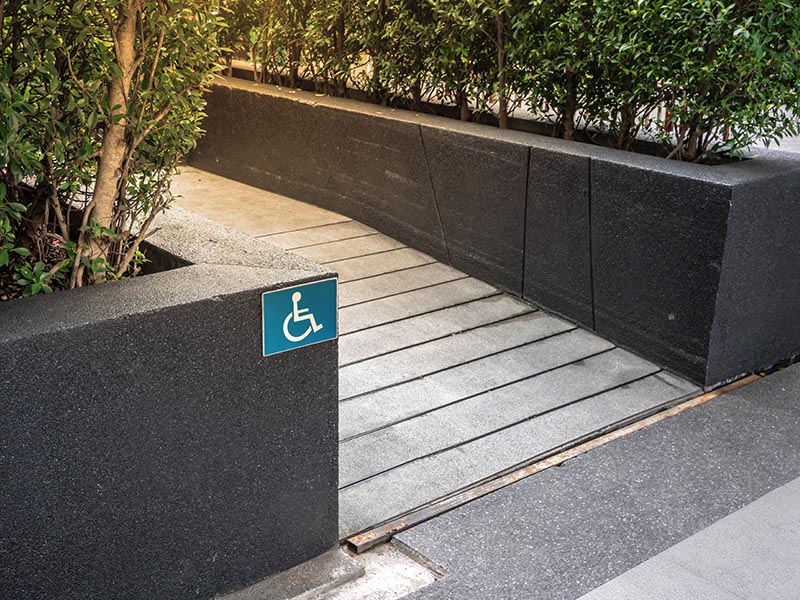The Americans with Disabilities Act (ADA) became law in 1990. It is a civil rights law that prohibits discrimination based on disability. Among many other things, ADA standards ensure the built environment is accessible for people with disabilities.
If your existing building isn’t ADA compliant, you’ll need to make upgrades. Or, if you’re planning a renovation, keep in mind that changes during a renovation can trigger ADA compliance and affect usability. This article will help you understand whether you need ADA renovations or upgrades and if your planned renovation will alter your facility’s accessibility.
THE IMPORTANCE OF UNDERSTANDING ADA REQUIREMENTS FOR RENOVATION PROJECTS
Businesses remodel, renovate, and upgrade all the time for various reasons. Whether you’re growing and need to expand or want to update an outdated workspace, if you’re planning to renovate, it’s important to keep ADA regulations in mind. An “alteration” is the term ADA uses to define a change to an existing building or facility that affects usability for people with disabilities. The ADA does not consider normal maintenance, reroofing, painting, wallpapering, asbestos removal, or changes to electrical and mechanical systems to be alterations.
HOW RENOVATION TRIGGERS ADA COMPLIANCE
Making changes to any area where people carry out one or more of the major activities for which a facility is used—meeting rooms, common areas, dining areas—are considered to be “primary function areas” under the ADA. Making alterations to any of these areas in your existing facility can alter your compliance with ADA regulations. When a primary function area is altered, the path to travel to an area where a person with disabilities works or is served as a customer is also altered.
To be sure you remain ADA compliant, you must remember a simple concept. What determines if a building is accessible is if the path a person travels from the parking lot to a primary function area meets accessibility standards. If people with disabilities do not have public accommodations to help them get from point A to point B, your renovation will trigger ADA compliance issues.
ADA UPGRADES—RENOVATING YOUR FACILITY FOR ADA COMPLIANCE
Maybe you haven’t been diligent when it comes to ADA compliance, but certain standards must be met for every aspect of your facility. Doors, hallways, restrooms, and entrances all have their own set of requirements that must be followed if you want to stay fully compliant.
ADA REQUIREMENTS FOR DOORS AND ENTRANCES
Chapter 4 of the ADA Standards covers entrances, doors, and gates. It states that at least 60% of public entrances must be accessible in new construction. Doors are not required to be automated but must comply when provided. The ANSI/BHMA Standards address operating characteristics, including door opening speed, safety features, sensors and activation devices, and labeling, among others. Doors are classified by their type or level of automation.
Other door and gate hardware requirements include:
- Door maneuvering clearances can be offset up to 8 inches from the face of the door.
- The height of thresholds is limited to ½ inch for all types of doors, including sliding doors.
- Door and gate hardware must allow for one-hand operation.
- Doors cannot require tight grasping, pinching, or twisting of the wrist.
- Gate and door hardware must be 34 to 48 inches above the floor or ground.
ADA REQUIREMENTS FOR RESTROOMS
It’s important to ensure the restrooms within your building are accessible to employees and customers with disabilities. These are the basic guidelines for single-user restrooms:
- A restroom must have 30-inch by 48-inch access to the sink (the door can’t swing into this rectangle).
- The centerline of the toilet must be between 16 and 18 inches from the sidewall.
- The room must have a clear circle of at least 60 inches around the sidewall and 56 inches from the rear wall to allow a wheelchair to turn.
- Toilet seat height must be 17 to 19 inches.
A key to achieving ADA compliance in restrooms involves choosing the highest-quality products. For example, consider solid, smooth surface lavatory systems with fully integrated sinks.
ADA REQUIREMENTS FOR HALLWAYS
To ensure people with disabilities are covered under the ADA, hallways and corridors in your building must be easily and comfortably accessible. It is important to follow these guidelines:
- Doorways connected to hallways must have an opening of at least 32 inches.
- Hallway widths must be at least 36 inches.
- In addition to ADA hallway width, corridors must provide hallway passing spaces. (Corridors should have a clear width of 60 inches.)
WE KEEP YOU COMPLIANT WITH ADA UPGRADES
It’s extremely important that your building is compliant with the Americans with Disabilities Act. Not only are you protecting your business from a lawsuit, but you are ensuring your facility can be used by diverse employees and customers. These laws aren’t just rules that have to be followed—they are what give people with disabilities an accessible route to the primary function areas within your building.
The experts at Skilled Services LLC have extensive knowledge about ADA compliance. We specialize in ADA upgrades for facilities that are not currently meeting compliance guidelines. Not sure if you’re fully compliant? Contact Skilled Services today for a full audit of your facility.




